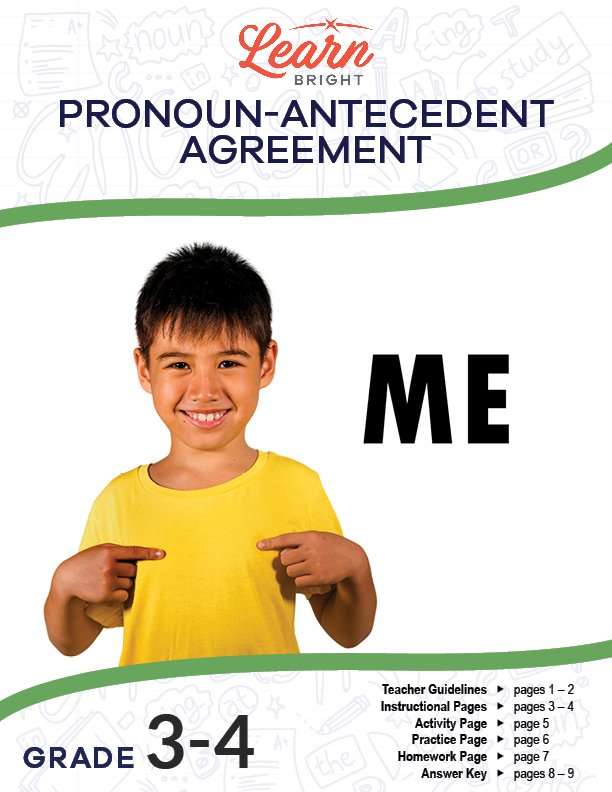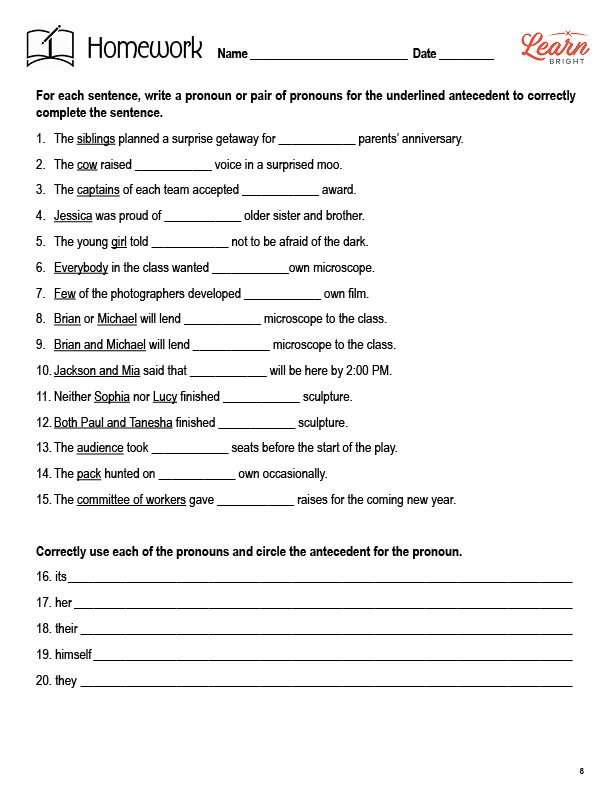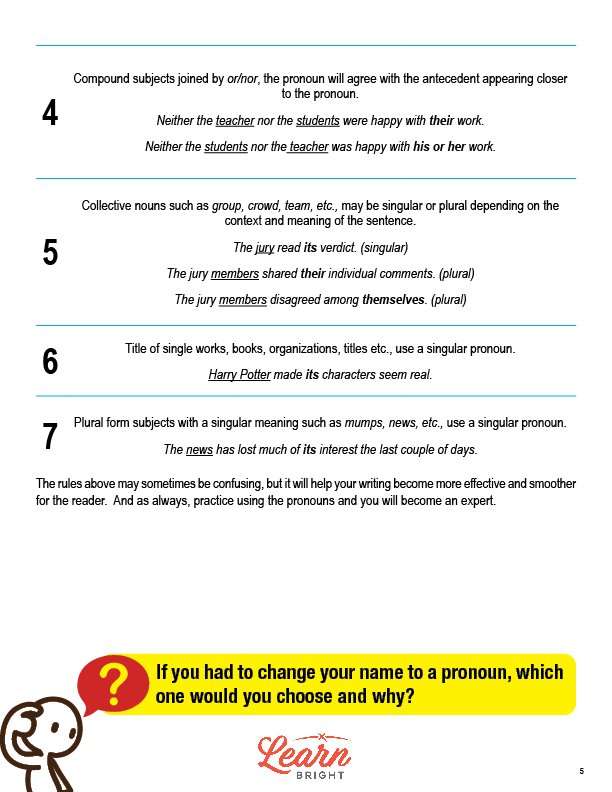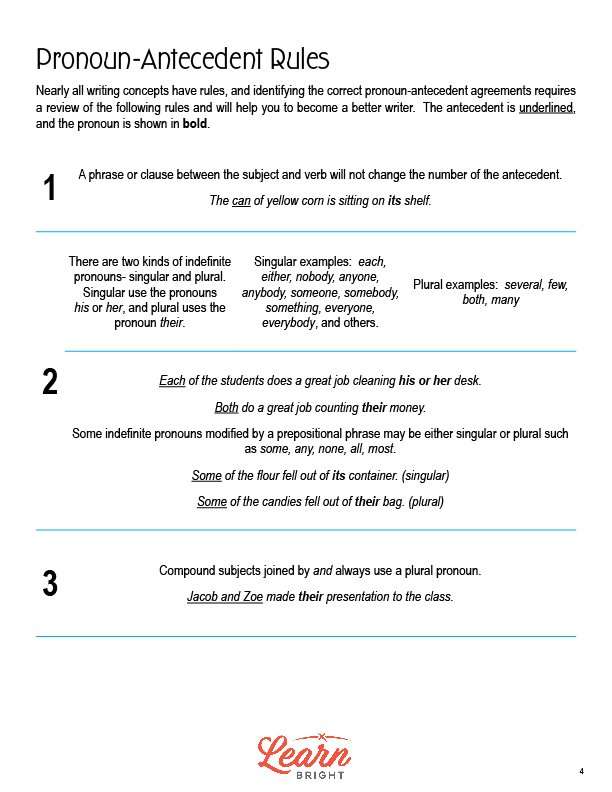Description
What our Pronoun-Antecedent Agreement lesson plan includes
Lesson Objectives and Overview: Pronoun-Antecedent Agreement focuses on the basics of pronoun-antecedent agreement. The lesson briefly reviews pronouns, and includes a chart of pronouns for student reference. Seven rules for correct pronoun-antecedent are listed in the lesson along with examples for each rule. At the end of the lesson, students will be able to ensure pronoun-antecedent agreement. This lesson is for students in 3rd grade and 4th grade.
Classroom Procedure
Every lesson plan provides you with a classroom procedure page that outlines a step-by-step guide to follow. You do not have to follow the guide exactly. The guide helps you organize the lesson and details when to hand out worksheets. It also lists information in the orange box that you might find useful. You will find the lesson objectives, state standards, and number of class sessions the lesson should take to complete in this area. In addition, it describes the supplies you will need as well as what and how you need to prepare beforehand. The supplies you will need for this lesson are scratch paper, final writing paper, and the handouts. To prepare for this lesson ahead of time, you can pair students for the activity, gather the supplies, and copy the handouts.
Options for Lesson
Included with this lesson is an “Options for Lesson” section that lists a number of suggestions for activities to add to the lesson or substitutions for the ones already in the lesson. The first few suggestions are for the lesson activity. It suggests that you can include additional pronouns and can allow students to add other sentences without pronouns. It also suggests that you can allow students to cast votes for the silliest, funniest, and most creative stories. A suggested addition to this lesson is to use current reading content and have students use it to identify pronouns and antecedents. Students could also write a story with characters but without pronouns, then rewrite it with correct pronoun usage. Finally, for the lesson closing, you could extend the question into an additional activity and have students make name tags and use their “new” names throughout the day.
Teacher Notes
The teacher notes page includes a paragraph with additional guidelines and things to think about as you begin to plan your lesson. It notes that this lesson can be used in conjunction with others about pronouns or other related language lessons. This page also includes lines that you can use to add your own notes as you’re preparing for this lesson.
PRONOUN-ANTECEDENT AGREEMENT LESSON PLAN CONTENT PAGES
Pronouns and Antecedents
The Pronoun-Antecedent Agreement lesson plan includes three content pages. It begins by stating that pronouns are words that take the place of a noun. Students will have already learned about pronouns and used them in their reading and writing. Pronouns either refer to earlier nouns or another pronoun. The lesson then gives two examples, one sentence without pronouns and one with. The sentence with pronouns is a better sentence because of the pronoun use. In that sentence, the name Jonathan, is the antecedent. Antecedents are nouns or pronouns to which another noun or pronoun refers. Antecedents typically appear before the pronoun.
Pronouns and antecedents must agree in both number and person. Since Jonathan is a male, you use the pronouns he and his. For a female person, you use the pronouns she and her, and for multiple people, you use they, them, and their. The lesson includes example sentences using all of these pronouns. The most important rule is that a singular pronoun must replace a singular noun, and a plural pronoun must replace a plural noun. The lesson also includes two short lists of singular and plural pronouns.
Pronoun-Antecedent Rules
Figuring out the correct pronoun-antecedent agreement requires you to review seven important rules. Each rule includes examples.
The first rule is that a phrase a clause between the subject and verb will not change the number of the antecedent. There are both singular and plural indefinite pronouns. Singular use his or her, and plural uses their.
The second rule is that some indefinite pronouns modified by a prepositional phrase may be either singular or plural. Some of these include some, any, none, all, and most.
The third rule is that compound subjects joined by the word and always use a plural pronoun. The fourth rule is that for compound subjects joined by or and nor, the pronoun agrees with the antecedent that appears closer to the pronoun.
The fifth rule is that collective nouns, like group, crowd, and team, can be either singular or plural depending on the context and the meaning of the whole sentence.
The sixth rule is that titles of single works, books, organizations, and titles use a singular pronoun. The seventh and final rule is that plural subjects that have a singular meaning (like mumps or news) use a singular pronoun.
These rules can be confusing, but they will help make sure that your writing is as effective as possible. Practice using pronouns will help you become an expert!
PRONOUN-ANTECEDENT AGREEMENT LESSON PLAN WORKSHEETS
The Pronoun-Antecedent Agreement lesson plan includes three worksheets: an activity worksheet, a practice worksheet, and a homework assignment. You can refer to the guide on the classroom procedure page to determine when to hand out each worksheet.
WRITE A STORY ACTIVITY WORKSHEET
Students will work with a partner to write a story. Every line of the story, apart from the opening and closing lines, must use one of the pronouns included on the activity worksheet. Students can use them in any order, but they must use each pronoun only one time. The story can be silly and creative. They will first write a rough draft and then write the final copy on a new piece of paper.
Students may work alone or in larger groups for this activity if you’d prefer.
CIRCLE THE PRONOUN PRACTICE WORKSHEET
For the practice worksheet, students will read 25 sentences and will circle the correct pronoun and underline its antecedent.
PRONOUN-ANTECEDENT AGREEMENT HOMEWORK ASSIGNMENT
The homework assignment asks students to complete two short exercises. The first asks them to fill in the blanks in sentences with a pronoun or pair of pronouns that matches the underlined antecedent in each sentence. The second asks them to correctly use five different pronouns in a sentence and circle the antecedent for each.
Worksheet Answer Keys
This lesson plan includes answer keys for the practice worksheet and the homework assignment. No answer key is provided for the activity worksheet as students’ answers will vary. If you choose to administer the lesson pages to your students via PDF, you will need to save a new file that omits these pages. Otherwise, you can simply print out the applicable pages and keep these as reference for yourself when grading assignments.









